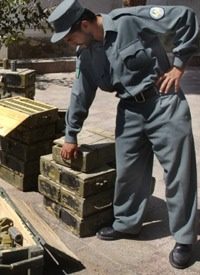
In an attempt to increase the size of the Afghan police force to 160,000, the United State military intends to invest more than $600 million to build approximately 200 police stations for the Afghan National Police by 2013.This was announced only days after President Obama signed an executive order establishing a new, bipartisan National Commission on Fiscal Responsibility and Reform.
Paul Giblin, spokesman for the U.S. Corps of Engineers, explained how the stations will be built. “There are five basic designs that are used for police stations, and they’re all pretty similar.” However, at the cost of nearly $3 million a police station, the structures will far surpass any standard set by local neighborhood precincts. In fact, the Afghan police stations will have a barbed wire perimeter with guards posted at each of the four corners. Additionally, reinforced concrete will make up the walls and roofs.
According to Thomas Day of McClatchy Newspapers, however, the designs for the police stations have been controversial. While the Corps of Engineers insists that the precincts should not have the appearance of bunkers, others believe that the police officers require more fortification to ensure their protection. Police Chief Abdul Karim Omaryar argues, “From the fighting point of view, they are vulnerable. It cannot resist small arms fire.” For the Afghan police officers, the targets of insurgent attacks, Omaryar raises a valid point.
Day writes, “If U.S. commanders have their way, the Afghan police won’t be spending much time in the stations anyway.” Per Brig. Gen. Larry Dudney, commander of security in the Afghan capital, “The police in Kabul are getting out a little bit more, spending more time with the local populace as opposed to sitting inside that police precinct.” Dudney argues that public police presence in Kabul will prove to be more efficient in the capturing of Taliban. The dispute over the structures, however, did not inhibit Washington from approving and signing the contracts for the stations.
As it goes, the $600 million will be tacked on to the approximate $1 trillion that has been allocated to the wars in Afghanistan and Iraq to date. This does not include the funds necessary to support the additional 30,000 troops sent to Afghanistan by Obama’s administration in December 2009.
If the Treasury Department is reporting that the United States federal budget deficit is running at a record-breaking pace, how is it possible to spend $600 million on Afghan police stations?
Ironically, on January 28, 2010, the U.S. Senate voted 60-40 for tough new curbs on federal spending. The measures require that parts of the budget must be paid for with either spending cuts or tax increases to prevent the federal deficit from rising.
Democratic Senate Majority Leader Harry Reid, chief sponsor of the proposed spending measures explains, “Let’s not kid ourselves: we are in this financial situation — and these pay-as-you-go rules are necessary — because we spent the last decade spending money we didn’t have.”
Apparently, the proposed freeze on federal spending exempts the wars in Afghanistan and Iraq, all other Pentagon spending, and foreign aid. It should not be too difficult to guess where the $600 million was found.
Photo of Afghan police: AP Images




